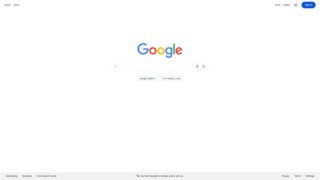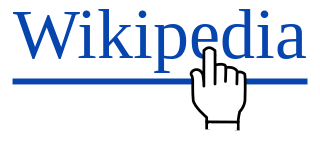Related Research Articles

Google Search is a search engine provided and operated by Google. Handling more than 3.5 billion searches per day, it has a 92% share of the global search engine market. It is the most-visited website in the world. Additionally, it is the most searched and used search engine in the entire world.
Spamdexing is the deliberate manipulation of search engine indexes. It involves a number of methods, such as link building and repeating unrelated phrases, to manipulate the relevance or prominence of resources indexed in a manner inconsistent with the purpose of the indexing system.
Search engine optimization (SEO) is the process of improving the quality and quantity of website traffic to a website or a web page from search engines. SEO targets unpaid traffic rather than direct traffic or paid traffic. Unpaid traffic may originate from different kinds of searches, including image search, video search, academic search, news search, and industry-specific vertical search engines.

On the World Wide Web, a link farm is any group of websites that all hyperlink to other sites in the group for the purpose of increasing SEO rankings. In graph theoretic terms, a link farm is a clique. Although some link farms can be created by hand, most are created through automated programs and services. A link farm is a form of spamming the index of a web search engine. Other link exchange systems are designed to allow individual websites to selectively exchange links with other relevant websites and are not considered a form of spamdexing.

The anchor text, link label or link text is the visible, clickable text in an HTML hyperlink. The term "anchor" was used in older versions of the HTML specification for what is currently referred to as the a element, or <a>. The HTML specification does not have a specific term for anchor text, but refers to it as "text that the a element wraps around". In XML terms, the anchor text is the content of the element, provided that the content is text.
The Sandbox effect is a name given to an observation of the way Google ranks web pages in its index. It is the subject of much debate—its existence has been written about since 2004, but not confirmed, with several statements to the contrary.

Matthew Cutts is an American software engineer. Cutts is the former Administrator of the United States Digital Service. He was first appointed as acting administrator, to later be confirmed as full administrator in October 2018. Cutts previously worked with Google as part of the search quality team on search engine optimization issues. He is the former head of the web spam team at Google.
An SEO contest is a prize activity that challenges search engine optimization (SEO) practitioners to achieve high ranking under major search engines such as Google, Yahoo, and MSN using certain keyword(s). This type of contest is controversial because it often leads to massive amounts of link spamming as participants try to boost the rankings of their pages by any means available. The SEO competitors hold the activity without the promotion of a product or service in mind, or they may organize a contest in order to market something on the Internet. Participants can showcase their skills and potentially discover and share new techniques for promoting websites.
nofollow is a setting on a web page hyperlink that directs search engines not to use the link for page ranking calculations. It is specified in the page as a type of link relation; that is: <a rel="nofollow" ...>. Because search engines often calculate a site's importance according to the number of hyperlinks from other sites, the nofollow setting allows website authors to indicate that the presence of a link is not an endorsement of the target site's importance.
Google Search Console is a web service by Google which allows webmasters to check indexing status, search queries, crawling errors and optimize visibility of their websites.

Mahalo.com was a web directory and Internet-based knowledge exchange launched in May 2007 by Jason Calacanis. It differentiated itself from algorithmic search engines like Google and Ask.com, as well as other directory sites like DMOZ and Yahoo! by tracking and building hand-crafted result sets for many of the currently popular search terms.
In the field of search engine optimization (SEO), link building describes actions aimed at increasing the number and quality of inbound links to a webpage with the goal of increasing the search engine rankings of that page or website. Briefly, link building is the process of establishing relevant hyperlinks to a website from external sites. Link building can increase the number of high-quality links pointing to a website, in turn increasing the likelihood of the website ranking highly in search engine results. Link building is also a proven marketing tactic for increasing brand awareness.

PageRank (PR) is an algorithm used by Google Search to rank web pages in their search engine results. It is named after both the term "web page" and co-founder Larry Page. PageRank is a way of measuring the importance of website pages. According to Google:
PageRank works by counting the number and quality of links to a page to determine a rough estimate of how important the website is. The underlying assumption is that more important websites are likely to receive more links from other websites.
A content farm or content mill is a company that employs large numbers of freelance writers or uses automated tools to generate a large amount of textual web content which is specifically designed to satisfy algorithms for maximal retrieval by search engines, known as SEO. Their main goal is to generate advertising revenue through attracting reader page views, as first exposed in the context of social spam.
A canonical link element is an HTML element that helps webmasters prevent duplicate content issues in search engine optimization by specifying the "canonical" or "preferred" version of a web page. It is described in RFC 6596, which went live in April 2012.
Yandex Search is a search engine. It is owned by Yandex, based in Russia. In January 2015, Yandex Search generated 51.2% of all of the search traffic in Russia according to LiveInternet.
Google's Google Panda is a major change to the company's search results ranking algorithm that was first released in February 2011. The change aimed to lower the rank of "low-quality sites" or "thin sites", in particular "content farms", and return higher-quality sites near the top of the search results.
Google Search, offered by Google, is the most widely used search engine on the World Wide Web as of 2023, with over eight billion searches a day. This page covers key events in the history of Google's search service.

This page provides a full timeline of web search engines, starting from the WHOis in 1982, the Archie search engine in 1990, and subsequent developments in the field. It is complementary to the history of web search engines page that provides more qualitative detail on the history.
Google Pigeon is the code name given to one of Google's local search algorithm updates. This update was released on July 24, 2014. It is aimed to increase the ranking of local listings in a search.
References
- 1 2 Matt Cutts. "Penguin Gets Official Name". Twitter.com. Retrieved June 5, 2018.
- ↑ "Webmaster Guidelines - Webmaster Tools Help". Google Inc. Retrieved June 5, 2018.
- ↑ "Link schemes - Webmaster Tools Help". Google Inc. Retrieved June 5, 2018.
- ↑ Barry Schwartz (February 20, 2013). "No, Google Hasn't Released Unannounced Penguin Updates" . Retrieved April 29, 2013.
- ↑ "Another step to reward high-quality sites".
- ↑ "A Guide To The Penguin Update - In Front Digital". In Front Digital. March 12, 2015. Retrieved June 13, 2016.
- ↑ "Here Is What It Looks Like To Be Hit By Google Penguin". seroundtable.com. Retrieved June 13, 2016.
- ↑ "Official Google Webmaster Central Blog: Page layout algorithm improvement". Googlewebmastercentral.blogspot.com. January 19, 2012. Retrieved June 5, 2018.
- ↑ "Google Updates Its Page Layout Algorithm To Go After Sites "Top Heavy" With Ads". SearchEngineLand.com. February 10, 2014. Retrieved July 10, 2014.
- ↑ "Google Penguin Update 3 Released, Impacts 0.3% Of English-Language Queries". Matt Cutts. October 5, 2012. Retrieved June 16, 2013.
- ↑ "Penguin 4, With Penguin 2.0 Generation Spam-Fighting". Matt Cutts. May 22, 2013. Retrieved July 10, 2014.
- ↑ "The Penguin 2.1 Spam-Filtering Algorithm". Matt Cutts. October 4, 2013. Retrieved July 10, 2014.
- ↑ "Penguin Algorithm, The Real Time Update".
- ↑ "Google Penguin 3.0 Likely Released Saturday Morning".
- ↑ "Google AutoCorrects: Penguin 3.0 Still Rolling Out & 1% Impact".
- ↑ Barry Schwartz (April 8, 2015). "Penguin & Panda still require manual updates". Search Engine Land. Retrieved April 30, 2015.
- ↑ "What is Google Penguin?". ahrefs.com. ahrefs.com.
- ↑ "Google Will Announce The Long-Anticipated Penguin Update". WebProNews. April 15, 2016. Archived from the original on November 13, 2021. Retrieved June 13, 2016.
- ↑ "Google updates Penguin, says it now runs in real time within the core search algorithm". Search Engine Land. September 23, 2016. Retrieved April 20, 2017.
- ↑ "Penguin 4.0: Necessary and positive improvement". Search Engine Land. October 25, 2016. Retrieved April 20, 2017.
- 1 2 "Google Penguin doesn't penalize for bad links - or does it?". Search Engine Land. September 28, 2016. Retrieved April 20, 2017.
- ↑ "Google Penguin looks mostly at your link source, says Google". Search Engine Land. October 10, 2016. Retrieved April 20, 2017.
- ↑ "Manual Actions report" . Retrieved September 5, 2017.
- ↑ "Feedback on our recent algorithm update ("Penguin")". April 24, 2012. Retrieved June 16, 2013.
- ↑ "Google Search Console". accounts.google.com. Retrieved October 29, 2021.
- ↑ "Google: Even Without Disavowing, Getting Good Links Can Remove Your Penguin Problems" . Retrieved June 25, 2015.
- ↑ "Another step to reward high-quality sites". Official Google Blog. April 24, 2012. Retrieved May 27, 2014.
- ↑ "Google Releases Penguin Update 2". Matt Cutts. May 26, 2012. Retrieved May 27, 2014.
- ↑ "Google Penguin Update 3 Released". Matt Cutts. October 5, 2012. Retrieved May 27, 2014.
- ↑ "Penguin 4, With Penguin 2.0 Generation Spam-Fighting". Matt Cutts. May 22, 2013. Retrieved May 27, 2014.
- ↑ "Penguin 5, With The Penguin 2.1 Spam-Filtering Algorithm". Matt Cutts. October 4, 2013. Retrieved May 27, 2014.
- ↑ "Google AutoCorrects: Penguin 3.0 Still Rolling Out & 1% Impact". Barry Schwartz. October 21, 2014. Retrieved October 21, 2014.
- ↑ Schwartz, Barry. "Google Penguin Reversals & Fluctuations This Morning". Search Engine Roundtable. SE Roundtable. Retrieved December 2, 2014.
- ↑ Illyes, Gary. "Penguin is now part of our core algorithm". Google Webmaster Central Blog. Google. Retrieved September 23, 2016.